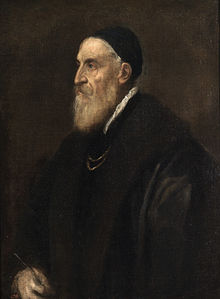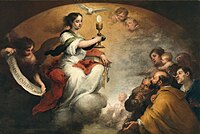
Back Titiaan Afrikaans Tizian ALS Tiziano AN تيتيان Arabic تيتيان ARZ Ticianu AST Tisian Veçellio Azerbaijani Тициан Bashkir Тыцыян Byelorussian Тыцыян BE-X-OLD
Titian | |
|---|---|
 | |
| Born | Tiziano Vecellio c. 1488/90 |
| Died | 27 August 1576 (aged 87–88) Venice, Republic of Venice |
| Nationality | Italian |
| Occupation | Artist |
| Movement | Venetian school |
| Signature | |
| Part of a series on |
| Catholic Counter-Reformation |
|---|
 |
| Catholic Reformation and Revival |
Tiziano Vecelli or Vecellio (pronounced [titˈtsjaːno veˈtʃɛlljo]; c. 1488/90[1] – 27 August 1576),[2] Latinized as Titianus, hence known in English as Titian (/ˈtɪʃən/ TISH-ən), was an Italian[a] (Venetian) Renaissance painter of Lombard origin,[4] considered the most important member of the 16th-century Venetian school. He was born in Pieve di Cadore, near Belluno.[5] During his lifetime he was often called da Cadore, 'from Cadore', taken from his native region.[6]
Recognized by his contemporaries as "The Sun Amidst Small Stars" (recalling the final line of Dante's Paradiso), Titian was one of the most versatile of Italian painters, equally adept with portraits, landscape backgrounds, and mythological and religious subjects. His painting methods, particularly in the application and use of colour, exerted a profound influence not only on painters of the late Italian Renaissance, but on future generations of Western artists.[7]
His career was successful from the start, and he became sought after by patrons, initially from Venice and its possessions, then joined by the north Italian princes, and finally the Habsburgs and papacy. Along with Giorgione, he is considered a founder of the Venetian school of Italian Renaissance painting.
During the course of his long life, Titian's artistic manner changed drastically,[8] but he retained a lifelong interest in colour. Although his mature works may not contain the vivid, luminous tints of his early pieces, they are renowned for their loose brushwork and subtlety of tone.
- ^ See below; c. 1488/1490 is generally accepted despite claims in his lifetime that he was older, Getty Union Artist Name List and Metropolitan Museum of Art timeline, retrieved 11 February 2009 both use c. 1488. See discussion of the issue below and at When Was Titian Born?, which sets out the evidence, and supports 1477—an unusual view today. Gould (pp. 264–66) also sets out much of the evidence without coming to a conclusion. Charles Hope in Jaffé (p. 11) also discusses the issue, favouring a date "in or just before 1490" as opposed to the much earlier dates, as does Penny (p. 201) "probably in 1490 or a little earlier". The question has become caught up in the still controversial division of works between Giorgione and the young Titian.
- ^ "Titian (ca. 1485/90?–1576)". Heilbrunn Timeline of Art History. Metropolitan Museum of Art. October 2003. Retrieved 30 January 2011.
- ^ Pliny the Younger, Letters 9.23.
- ^ Joseph Archer Crowe (March 2011). Titian - His Life and Times, with some account of his family, chiefly from new and unpublished records -. Read Books Design. ISBN 978-1-4460-5468-0.
- ^ Wolf, Norbert (2006). I, Titian. New York and London: Prestel. ISBN 9783791333847.
- ^ Rossetti 1911, p. 1023.
- ^ Fossi, Gloria, Italian Art: Painting, Sculpture, Architecture from the Origins to the Present Day, p. 194. Giunti, 2000. ISBN 88-09-01771-4
- ^ The contours in early works may be described as "crisp and clear", while of his late methods it was said that "he painted more with his fingers than his brushes." Dunkerton, Jill, et al., Dürer to Veronese: Sixteenth-Century Painting in the National Gallery, pp. 281–286. Yale University, National Gallery Publications, 1999. ISBN 0-300-07220-1
Cite error: There are <ref group=lower-alpha> tags or {{efn}} templates on this page, but the references will not show without a {{reflist|group=lower-alpha}} template or {{notelist}} template (see the help page).
© MMXXIII Rich X Search. We shall prevail. All rights reserved. Rich X Search